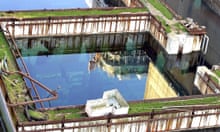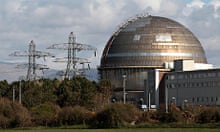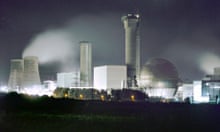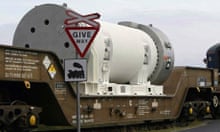Fears of a radioactive leak at the Sellafield nuclear site in Cumbria on Friday morning were triggered by a rise in the natural background levels of radon gas, investigators have said.
Operators of the nuclear reprocessing facility told thousands of non-essential staff to stay at home after a perimeter alarm at the north end of the site measured higher than normal levels of radiation.
Managers at Sellafield said that radiation picked up by the monitoring device was extremely low and posed no danger to the workforce or public, and that the decision to limit staff on the site had not interfered with normal running of the site.
In a statement, the company said: "Sellafield Ltd can confirm that the radioactivity detected by one of our in-air monitors overnight is not attributable to any issue or problem with any of our operations on site.
"Our in-air monitors are extremely sensitive and pick up on any abnormality. Overnight the monitoring system initially indicated elevated levels of activity. Following investigation and analysis, we can now confirm these levels to be naturally occurring background radon."
The government's safety watchdog, the Office for Nuclear Regulation, had its incident suite on standby in case the situation turned into a full-scale emergency, while the government's technical adviser, Mike Finnerty, was called in to consult on the investigation.
Radioactive radon gas is emitted naturally from certain rocks and seeps up through the ground, though levels are typically not very high in Cumbria. The spike in radon gas at the site might have been caused by a low pressure weather system coming in from the west.
Officials at the site are investigating why only one radioactive monitor at the edge of the site picked up the higher radiation level. None of the radiation detectors in and on buildings at site went off.
A Sellafield spokesman told the Guardian that staff would not be called back to work on Friday but were expected to return as usual over the weekend or Monday, depending on their shifts.
Gary Smith, the national secretary for energy at the GMB union, said the majority of Sellafield's workforce had been told not to turn up for work on Friday morning. The site employs more than 10,000 people. The unusual radiation reading at the perimeter fence had been detected at 2am, he said.
The statement from Sellafield continued: "The number one priority for us is, at all times, safe secure stewardship of the Sellafield site, which is the most complex and challenging nuclear site in Europe.
"As such we act in a safety conscious manner, and take cautious, conservative decisions, such as the one taken overnight to ask non-safety essential staff to stay at home this morning, rather than come to the site.
"All of our plants and storage facilities were quickly confirmed as operating normally, and we were always confident that the issue posed no risk to the workforce or public because the levels being detected, whilst above background radiation levels, were still low. This view was reinforced by the fact that none of our other installed monitors were picking up any kind of increased levels – however, we take such issues so seriously that we investigated fully to confirm that everything was okay."
Additional reporting: Adam Vaughan, Leila Haddou and Rob Edwards










Comments (…)
Sign in or create your Guardian account to join the discussion